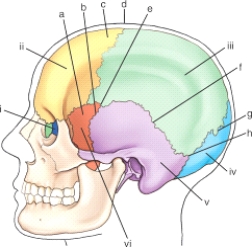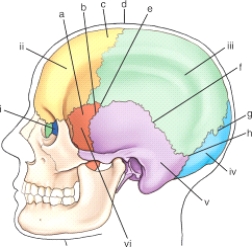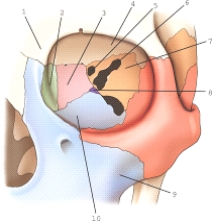A) PA
B) Parietoacanthial
C) Parietoacanthial transoral
D) Horizontal beam lateral
F) A) and C)
Correct Answer

verified
Correct Answer
verified
Multiple Choice
Which cranial bone is labeled vi in this figure?  (Anatomic structures are labeled i through vi and sutures a through h.)
(Anatomic structures are labeled i through vi and sutures a through h.)
A) Temporal
B) Occipital
C) Greater wing of sphenoid
D) Parietal
F) All of the above
Correct Answer

verified
Correct Answer
verified
Multiple Choice
What is the maximum CR angulation used for the axiolateral/axiolateral oblique projection of the mandible?
A) 10° to 15°
B) 25°
C) 30°
D) 45°
F) A) and C)
Correct Answer

verified
Correct Answer
verified
Multiple Choice
Select the imaging modality that would best demonstrate the following pathologies. -Most sensitive modality for detecting differences between normal and abnormal brain tissues
A) Nuclear medicine
B) MRI
C) CT
D) Ultrasound
E) Conventional radiography
G) A) and E)
Correct Answer

verified
Correct Answer
verified
Multiple Choice
Select the imaging modality that would best demonstrate the following pathologies. -Intracranial hemorrhage in premature infants
A) Nuclear medicine
B) MRI
C) CT
D) Ultrasound
E) Conventional radiography
G) A) and C)
Correct Answer

verified
Correct Answer
verified
Multiple Choice
The frontal bone articulates with ____ cranial bones.
A) four
B) six
C) two
D) five
F) A) and D)
Correct Answer

verified
Correct Answer
verified
Multiple Choice
A patient comes to radiology with a clinical history of an acoustic neuroma.Which of the following imaging modalities will provide the best assessment for this tumor?
A) Radiography
B) Ultrasound
C) Nuclear medicine
D) MRI
F) None of the above
Correct Answer

verified
Correct Answer
verified
Multiple Choice
The suture labeled f is the:  (Anatomic structures are labeled i through vi and sutures a through h.)
(Anatomic structures are labeled i through vi and sutures a through h.)
A) asterion.
B) lambdoidal.
C) coronal.
D) squamosal.
F) None of the above
Correct Answer

verified
Correct Answer
verified
Multiple Choice
Which division of the temporal bone contains the organs of hearing and equilibrium?
A) Petrous
B) Mastoid
C) Squamous
D) Antrum
F) A) and B)
Correct Answer

verified
Correct Answer
verified
Multiple Choice
A patient comes to radiology for a sinus series.She cannot fully extend her head and neck for the submentovertical projection.What else can the technologist do to produce a diagnostic submentovertical projection?
A) Angle the CR to place it perpendicular to the OML.
B) Angle the CR to place it perpendicular to IOML.
C) Perform the projection with the patient recumbent.
D) Place sandbags on the forehead to extend the skull.
F) B) and C)
Correct Answer

verified
Correct Answer
verified
Multiple Choice
The ethmoid notch is part of which cranial bone?
A) Temporal
B) Ethmoid
C) Sphenoid
D) Frontal
F) All of the above
Correct Answer

verified
Correct Answer
verified
Multiple Choice
What is the angle between the OML and the plane of the IR for the parietoacanthial (Waters) projection?
A) 40°
B) 37°
C) 42°
D) 15° to 20°
F) C) and D)
Correct Answer

verified
Correct Answer
verified
Multiple Choice
The term antrum of Highmore is an older term for the:
A) frontal sinuses.
B) ethmoid sinuses.
C) maxillary sinuses.
D) nasal cavity.
F) B) and D)
Correct Answer

verified
Correct Answer
verified
Multiple Choice
A radiograph of an anteroposterior (AP) axial projection of the cranium reveals that the dorsum sellae is projected below the foramen magnum, but the posterior arch of C1 is visible within the foramen.Which of the following positioning errors led to this radiographic outcome?
A) Excessive central ray (CR) angulation
B) Insufficient CR angulation
C) Insufficient flexion of the head and neck
D) Tilt of the skull
F) A) and C)
Correct Answer

verified
Correct Answer
verified
Multiple Choice
Which of the following landmarks corresponds with the level of the petrous ridge?
A) EAM
B) Top of ear attachment (TEA)
C) Squamosal suture
D) Inion
F) A) and B)
Correct Answer

verified
Correct Answer
verified
Multiple Choice
Part 6 is which of the following? 
A) Inferior orbital fissure
B) Optic foramina
C) Superior orbital fissure
D) Lacrimal duct
F) B) and D)
Correct Answer

verified
Correct Answer
verified
Multiple Choice
The slight depression above each eyebrow is termed the:
A) glabella.
B) supraorbital foramina.
C) supraorbital groove.
D) frontal tuberosity.
F) B) and C)
Correct Answer

verified
Correct Answer
verified
Multiple Choice
Which of the following bones is part of the floor of the cranium?
A) Temporal
B) Occipital
C) Frontal
D) Parietal
F) None of the above
Correct Answer

verified
Correct Answer
verified
Multiple Choice
Which of the following terms describes the junction of the two nasal bones?
A) Nasion
B) Acanthion
C) Glabella
D) Supraorbital groove
F) A) and C)
Correct Answer

verified
Correct Answer
verified
Multiple Choice
Which cranial bone possesses the sella turcica?
A) Temporal
B) Sphenoid
C) Ethmoid
D) Occipital
F) A) and D)
Correct Answer

verified
Correct Answer
verified
Showing 141 - 160 of 181
Related Exams